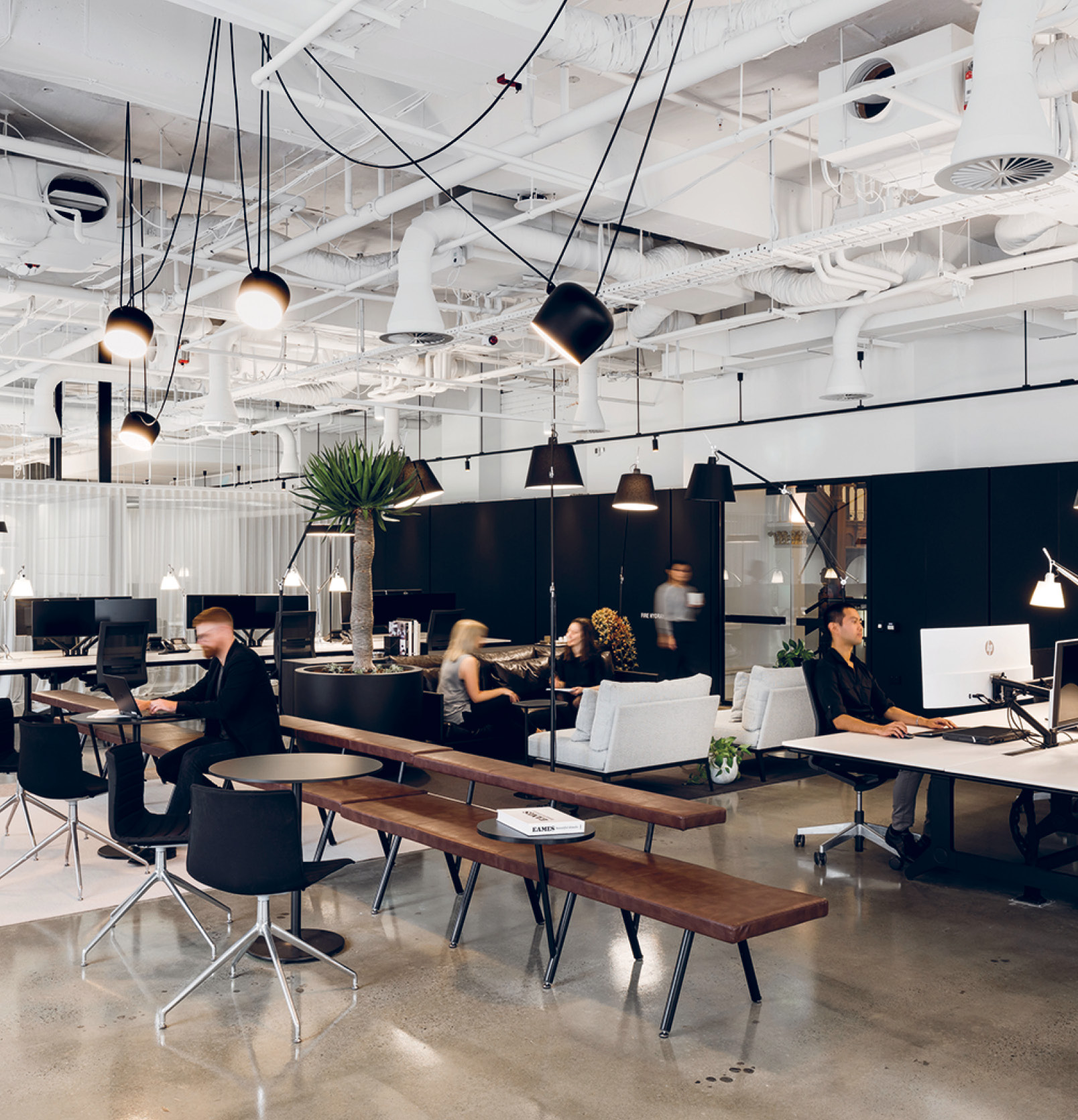
Reframing the Office as the Engine Room
Working from home may have some employee benefits but what we’re not talking about is its negative impact on innovation, delegation and empowerment. This is a big problem for businesses. So, how do we make the office a more compelling destination that draws people back? Here are 10 key ways to bring the office back to life.
Much has been written about COVID-19’s impact on the commercial office. While some of it may eventuate, a lot of it comes down to crystal ball gazing. The media is fixated on the employee benefits of working from home (WFH) but there has been disturbingly little interest in how these assumed permanent changes will impact employers, business viability, landlords and nearby ancillary small businesses and city centres.
Real collaboration and idea generation often relies on face to face meetings, brainstorming, or just bumping into someone in the hallway. These chance encounters are also a key component of workplace joy. WFH doesn’t allow for this and, what’s more, it’s also having a detrimental effect on innovation. A study by Boston Consulting Group and KRC Research, commissioned by Microsoft, showed that innovation dropped by as much as 40 per cent as workforces became dispersed in 2020. It also showed that executives have struggled to effectively delegate and empower teams virtually. That’s a big problem for business, one we should be talking about.
Until people return to city offices, small businesses on the street will not be viable; many cannot reopen. This will have a big impact on the dynamism and desirability of entire cities.
So how do we make the office a more compelling destination and draw people back? How do we remind employees that their offices are communities where valuable relationships are created and developed, and where skills are built? And what can developers and landlords do to positively engage tenants and create an environment for them to do their best work now and in the future?
Here are 10 ideas to bring the office back to life:
- Flip the conversation to space utilisation
We need a new narrative for companies considering sub-leasing as a solution for unused space. Promote re-use of space dedicated to single use activities and areas for quiet work: staff training rooms, meeting rooms, private offices, brainstorm spaces, podcast spaces, reading rooms, zoom rooms, telephone rooms, etc. Create a new expectation of how much space companies should include as a mandatory, for health and safety reasons. So instead of 8-12sqm per person, promote a new future expectation of 13-18sqm per person. The best way to create this new narrative is with scientific data, and survey outcomes – which can be built into marketing messages for future buildings.
- Stronger wellness cultures
Think designated space for preventative care which comprises dedicated rooms and adjoining spaces for training, as well as for activities such as yoga, Pilates, boot camps and guest speakers who can lecture on everything from stress management to nutrition. This shift will be permanent, meaning adapting to it is crucial for any asset owner wanting to stay ahead of the competition through differentiation, engagement and service. And just like the philosophy inherent within our Place VisioningTM service, this will enable developers and asset owners to deliver social benefits while improving long term economic performance.
- Space for trust
You create trust in a work relationship through rapport. And a workforce without trust erodes the culture of an organisation. Social engagement in the office is critical for employees to create social networks and connect to one another. So offices need to invest in more social spaces, like the central atrium planned for 121 Castlereagh by Cbus, which will inspire connectivity and meaningful social interactions between the different floors.
- Amplify inspiration
Bring in outside speakers once a week to add to people’s ongoing training and general inspiration. This is obviously a task for the tenant, but landlords should consider designing or repurposing spaces to create “tiered town hall” type areas. When not in use these can be used as breakout spaces, lunch spaces or spots for quiet discussions and phone calls.
- A buzz on the ground becomes the brand
The ground floor establishes a building’s brand, but curation of retail and F&B is often not considered beyond a basic cafe because 99 per cent of the revenue comes from the office floors upstairs. If, however, commercial office developments gave more thought and consideration to the offer and experiences on the ground floor, the entire building would become a destination for the surrounding public, potentially attracting visitors from 8am to 10pm in some CBD precincts. In an ideal world, commercial office buildings would work with their neighbours to curate the ground plane, ensuring permeable destination precincts with varied amenity that magnetically draw people from the surrounding area each day.
- Make it feel like a club
Combining services and destinational experiences into one area would help increase the impact of a space. By co-locating co-working, meeting spaces and cafes into one area a private club a Soho House environment could be achieved, with lounges and big tables, all with full F&B table service. These buzzing, magnetic spaces would attract outside guests to visit and use.
- Spaces for staff training
When people learn more skills, the employee and the employer benefit. Creating interactive training modules -which have a better outcome when taught in the same physical environment – could be a way to engage employees and bring them into the office. Training and company development have the potential to join forces: as people are learning new skills, the company is creating new services, products or processes to improve the organisation. This is innovation in action. Landlords need to consider what they can do to influence or assist in creating environments for internal training.
- And spaces for silence
Open plan offices, especially when cramped, can have detrimental impacts on productivity thanks to noise and lack of privacy. One of the things people so enjoyed about WFH was the lack of interruptions and ability to really focus on the task in hand. So, think about putting an emphasis on private spaces (not just private offices) and quiet nooks which will increase comfort and focus, and thus productivity.
- Activate rooftops
Rooftop spaces are the biggest missed opportunity in the property sector. They represent an important example of how we must look differently at the use of common spaces. If we applied a placemaking lens to commercial office buildings one of the first things to consider would be, where practical, rooftops that could be transformed into destinations. There are a host of activities which could occur on the rooftop, from outdoor exercise, to calm spaces, to outdoor meeting rooms, to daytime cafes and night time bars. Lift access is of course a consideration, as are local council rules and restrictions. However, there are dozens of buildings in each capital city’s CBD which could, with modest expenditure, bring their rooftops to life, engaging and enticing their tenants along the way.
- Laundry services
As a result of COVID-19 more people are eschewing public transport and driving to work, so developers might need to think about creating additional carparks to cater for them. If that is the case, and more tenants enter the building from the car park, then an immediately accessible laundry service is worth considering. For the huge number of working parents in particular, imagine getting out of your car and dropping off the washing, ironing and dry-cleaning for a next day pick-up. The laundry service would also represent an additional rent-paying tenant.
These are just a few thoughts to inspire you to give more consideration to your current assets and future development opportunities. For some of us, work is exciting. For others, it’s a chore. Either way, there’s no denying the value of constructive work relationships and learning on the job – regardless of your role. So, let’s inspire people to see the office as the only place possible for that to occur.
Back




